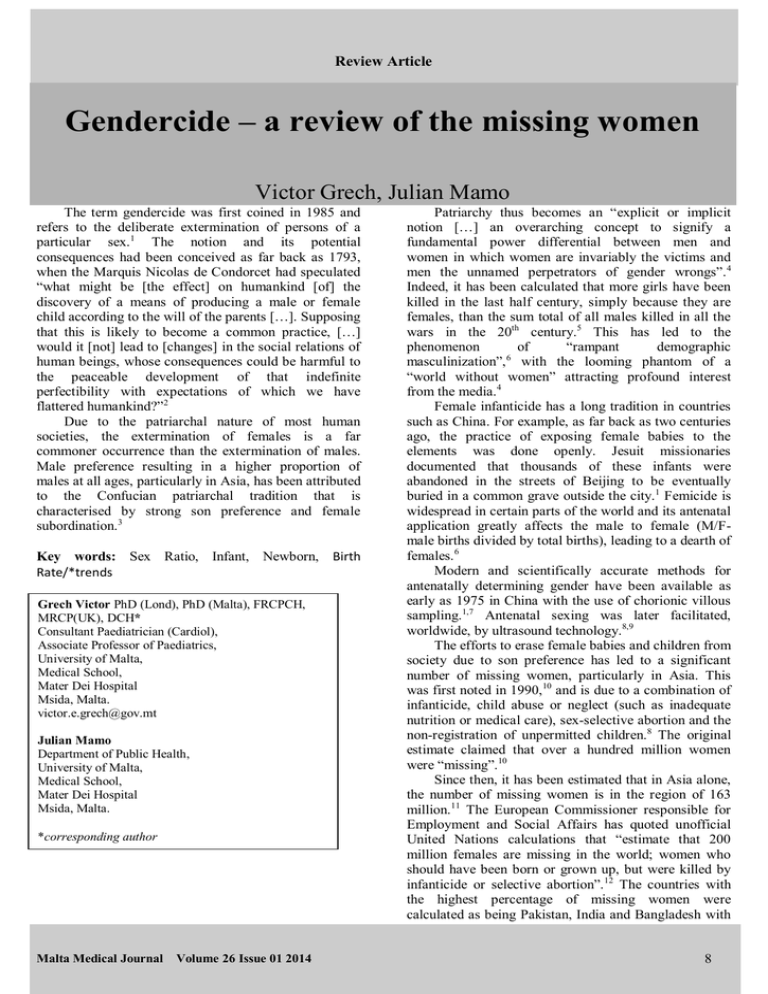Review Article
advertisement

Review Article Gendercide – a review of the missing women Victor Grech, Julian Mamo The term gendercide was first coined in 1985 and refers to the deliberate extermination of persons of a particular sex.1 The notion and its potential consequences had been conceived as far back as 1793, when the Marquis Nicolas de Condorcet had speculated “what might be [the effect] on humankind [of] the discovery of a means of producing a male or female child according to the will of the parents […]. Supposing that this is likely to become a common practice, […] would it [not] lead to [changes] in the social relations of human beings, whose consequences could be harmful to the peaceable development of that indefinite perfectibility with expectations of which we have flattered humankind?”2 Due to the patriarchal nature of most human societies, the extermination of females is a far commoner occurrence than the extermination of males. Male preference resulting in a higher proportion of males at all ages, particularly in Asia, has been attributed to the Confucian patriarchal tradition that is characterised by strong son preference and female subordination.3 Key words: Sex Ratio, Infant, Newborn, Birth Rate/*trends Grech Victor PhD (Lond), PhD (Malta), FRCPCH, MRCP(UK), DCH* Consultant Paediatrician (Cardiol), Associate Professor of Paediatrics, University of Malta, Medical School, Mater Dei Hospital Msida, Malta. victor.e.grech@gov.mt Julian Mamo Department of Public Health, University of Malta, Medical School, Mater Dei Hospital Msida, Malta. *corresponding author Malta Medical Journal Volume 26 Issue 01 2014 Patriarchy thus becomes an “explicit or implicit notion […] an overarching concept to signify a fundamental power differential between men and women in which women are invariably the victims and men the unnamed perpetrators of gender wrongs”. 4 Indeed, it has been calculated that more girls have been killed in the last half century, simply because they are females, than the sum total of all males killed in all the wars in the 20th century.5 This has led to the phenomenon of “rampant demographic masculinization”, 6 with the looming phantom of a “world without women” attracting profound interest from the media.4 Female infanticide has a long tradition in countries such as China. For example, as far back as two centuries ago, the practice of exposing female babies to the elements was done openly. Jesuit missionaries documented that thousands of these infants were abandoned in the streets of Beijing to be eventually buried in a common grave outside the city.1 Femicide is widespread in certain parts of the world and its antenatal application greatly affects the male to female (M/Fmale births divided by total births), leading to a dearth of females. 6 Modern and scientifically accurate methods for antenatally determining gender have been available as early as 1975 in China with the use of chorionic villous sampling.1,7 Antenatal sexing was later facilitated, worldwide, by ultrasound technology.8,9 The efforts to erase female babies and children from society due to son preference has led to a significant number of missing women, particularly in Asia. This was first noted in 1990,10 and is due to a combination of infanticide, child abuse or neglect (such as inadequate nutrition or medical care), sex-selective abortion and the non-registration of unpermitted children.8 The original estimate claimed that over a hundred million women were “missing”.10 Since then, it has been estimated that in Asia alone, the number of missing women is in the region of 163 million.11 The European Commissioner responsible for Employment and Social Affairs has quoted unofficial United Nations calculations that “estimate that 200 million females are missing in the world; women who should have been born or grown up, but were killed by infanticide or selective abortion”.12 The countries with the highest percentage of missing women were calculated as being Pakistan, India and Bangladesh with 8 Review Article 11, 9.4 and 8.9% of all missing females respectively. This paradigm is prompted by social, cultural, political and economic factors.13,14 These are predominantly caused by the tendency for patrilineal inheritance in patriarchal societies coupled with a reliance on male children to provide economic support indefinitely. This is especially so when sons are higher wage earners than daughters, by far the commoner situation. For example, in India, female children are considered less desirable as they require a dowry to be married off (while a marrying male brings in a dowry), and male children along with their wives and families are expected to care for the husband’s (and not the wife’s) parents.15 For this reason, in this country alone, it was calculated in 2006 that half a million female foetuses had been aborted annually, resulting in a deficit (up to that time) of approximately 10 million female foetuses over the previous two and a half decades. 16 Neglect also kills. For example, in India, a form of discriminatory behaviour may commence before birth. It has been shown that when it is known that the foetus is female, failure to attend antenatal clinics and take the tetanus vaccine accounts for 4-10.5% of the excess female neonatal mortality.17 Thus, even when female pregnancies are carried to term, neglect can still lead to death. Women in such countries may experience tremendous social pressure to produce sons, becoming repeatedly pregnant until they do so, since failure may incur violence, rejection or even death. 18 This attitude is also prevalent, albeit less strongly, in more developed countries and it has been stated, based on a United States National fertility study, that “the most lasting implication of the introduction of sexcontrol technologies would appear to be a significant increase in the probability of the firstborn being a male, and the second child being a female”.19 This mind-set prevails in all social classes, such that even in the United States, a large sample of university students revealed that 85% preferred a firstborn male and 73% desired a second child to be female.20 Gender-selective abortion is the commonest form of femicide, and remains in widespread use in Asia and in countries with a high population of Asian immigrants. 21 There is also evidence of its use even among particular ethnic groups in more developed countries, such as the United States, where it has been shown that for third and higher order births, M/F was significantly elevated in Chinese, Asian Indians and Koreans.22 Similarly, in Canada, it has been shown that M/F in multiparous women who had been born in India was significantly higher than that of multiparous women born in Canada.23 Malta Medical Journal Volume 26 Issue 01 2014 In countries with reduced fertility, the M/F skew is very high, as experienced in China with its one-family, one-child policy. This had been enforced in China in 1979 following a government attempt to overcome the economic stagnation engendered by the so-called “Cultural Revolution.” At this time, China contained a quarter of all of humanity on seven percent of the planet’s arable land, with two thirds of its population aged under thirty years. The Communist government perceived this policy as essential to an improvement in living standards by economic reform. And in a society which prizes males, the parents will desire that the single child will be male at any cost. The policy was enforced by discretionary rewards and punishments which included large fines, confiscations of belongings, obligatory abortions and dismissal from work. In rural areas, a second child was generally permitted only if the first child was female, a clear acknowledgment of the traditional son preference. 24 The widespread nonreporting of unwanted or abandoned female babies was also common in China, often with the collusion of local authorities.25 Asian governments, cognizant of the problems of M/F distortion, have sought to outlaw all forms of femicide, with limited effect,24 and it seems that change can only come about slowly with increased population education. For example, South Korea was in the forefront in the utilisation of sex-selective technology, greatly distorting the country’s M/F.26 However, by 2007, M/F in this country had dropped to conventionally accepted values, probably due to rapid economic growth and development, with a reduced son preference. 27 It is also theoretically possible for couples to deliberately influence M/F without resorting to abortion, such as by timing coitus within the menstrual cycle or even by choosing the time of conception within the calendar year.28 In the interim, until M/F normalises, the social consequences are expected to be catastrophic. For example, it is estimated that in parts of China and India, there will be an excess of 12–15% young men, to their great detriment, since in these regions, marriage is highly desirable and a crucial factor on which social status and acceptance depends.29 It was estimated that the global sex ratio for 2012 was 0.5169.30 The global effects on the sex ratio assuming a current ratio of 0.5169 and a world population of 7 billion are shown in Table 1 using quadratic equations for exact calculation of 95% confidence intervals for ratios.31 This table factors in female deficits ranging from 100 to 200 million (assuming that all such females have survived). 9 Review Article Table 1: Effects of missing women on global M/F assuming a current global sex ratio of 0.5169 30 Assumed female deficit None (observed) Missing females % 100000000 150000000 200000000 1.43 2.14 2.86 - Calculated male population 3618357488 3618357488 3618357488 3618357488 Calculated female population 3381642512 3481642512 3531642512 3581642512 Total 7000000000 7100000000 7150000000 7200000000 Upper confidence interval 0.51692 0.50964 0.50608 0.50256 M/F 0.51691 0.50963 0.50606 0.50255 Lower confidence interval 0.51690 0.50962 0.50605 0.50254 Missing females displayed as a percentage of current total global population The large number of missing women has led to speculation that there will be increased levels of antisocial behaviour and violence in such regions. 32 For example, in China, unmarried men are known as guanggun (bare sticks), with implications of being outcast and somehow threatening to the public order. In popular lore, moreover, guanggun were associated with bullying and banditry.4 Such individuals are likely to be drawn toward military organizations, potentially threatening global security, especially since this demographic imbalance will occur in global political hotspots.29 There is historical precedent for this as it has been noted that male population youth bulges appeared to precipitate Europe’s imperial expansion after 1500, Japan’s imperial expansion after 1914, the Cold War civil uprisings in Algeria, El Salvador, and Lebanon, and the recent rise of Islamist extremism in Muslin countries such as Afghanistan, Iraq and Pakistan. It has been argued that “third and fourth sons” frequently fail to find prestigious or meaningful positions in their societies and channel their energies into religious and/or political ideologies. 33 Developed countries are not immune to these effects. It has been shown that a male-biased secondary sex ratio (the sex ratio in mature and fertile adults) influences men such that they forego considerations about the future and attempt to access immediate rewards, along with a willingness to incur debt for immediate expenditures. Such men are willing to spend more money on courtship behaviour (such as engagement rings), even if this means leaving them indebted.34 The situation has been compared with Ernest Hemingway’s collection of short stories, Men Without Malta Medical Journal Volume 26 Issue 01 2014 Women35 which features gangsters, bullfighters, wounded soldiers, and killers.36 This scenario has also been extensively explored in science fiction.37 These negative outcomes may well occur despite the fact that one of the few positive consequences of selective abortion should be a reduction in the number of unwanted children. The situation could eventually be self-limiting since any gender imbalance will lead to a reduction in birth rates. In addition, as the number of girls decreases, their social status should increase due to their rarity, leading to a decline in son preference. 38 Furthermore if, due to scarcity, a significant proportion of men marry older women, there should be fewer single, lonely individuals in old age since women have a greater life expectancy than men. 32 Fortunately, the younger generations already show signs of self-remedying this state of affairs in that the traditional preference for boys may be changing.39 The Chinese National Family Planning and Reproductive Health Survey of 2001 showed that 37% of women claimed to have no offspring gender preference, 45% stated that the ideal family consisted of one boy and one girl, and in the case of one offspring, women were slightly more in favour of having one girl than one boy.40 There is thus yet hope that the man-made imbalance in M/F may be alleviated by improved levels of education and better standards of living. References 1. 2. Warren MA. Gendercide: The implications of sex selection. New Jersey: Rowman & Allanheld. 1985. Condorcet. Esquisse d’un tableau historique des progrès de l’esprit humain. Ouvrage posthume de Condorcet. Paris: Agasse; 2004. 10 Original Article 3. 4. 5. 6. 7. 8. 9. 10. 11. 12. 13. 14. 15. 16. 17. 18. 19. 20. 21. 22. 23. 24. 25. 26. 27. Poston D, Zhang I. China’s unbalanced sex ratio at birth: How many surplus boys have been born in China since the 1980s? In Tucker J, Poston D eds. Gender Policy and HIV in China: Catalyzing Policy Change. New York: Springer; 2009. Greenhalgh . Patriarchal Demographics? China’s Sex Ratio Reconsidered. Pop Dev Rev 2013;38:130-149. De Reus LA. Half the Sky: Turning Oppression Into Opportunity for Women Worldwide. J Family Theory & Rev 2010;2:98-103. Russell DEH, Harmes RA. Femicide in Global Perspective New York: Teachers College Press, 2001. Coale AJ, Banister J. Five decades of missing females in China. Demography 1994;31:459-479. Hull TH. Recent trends in sex ratios at birth in China. Pop Dev Rev 1990;16: 63-83. Arnold F, Kishor S, Roy TK. Sex-Selective Abortions in India. Pop Dev Rev 2002;28:759–85. Sen A. More Than 100 Million Women Are Missing (20 December 1990). New York Review of Books 1990,37:20. Guilmoto CZ. Sex-ratio imbalance in Asia: Trends, consequences and policy responses. LPED/IR 2007 Paris:112. Diamantopoulou A. Violence against Women: Zero Tolerance. Lisbon, Centro de Congressos de Lisboa, 4-6 May 2000. http://europa.eu/rapid/press-release_SPEECH-00161_en.pdf Sen A. Missing women. BMJ. 1992;304:587-8. Sen A. BMJ. Missing women – revisited. 2003;327:1297-8. Leone T, Matthews Z, Dalla Zuanna G. Impact and determinants of sex preference in Nepal. Int Fam Plan Perspect. 2003;29:69-75. Jha P, Kumar R, Vasa P, Dhingra N, Thiruchelvam D, Moineddin R. Low female[corrected]-to-male [corrected] sex ratio of children born in India: national survey of 1.1 million households. Lancet 2006;367:211-218. Bharadwaj P, Lakdawala LK. Discrimination begins in the womb: evidence of sex-selective prenatal investments. J Hum Resources 2013;48: 71-113. OHCHR, UNFPA, UNICEF, UN Women, WHO. Preventing gender-biased sex selection. Geneva; WHO; 2011. Westoff CF, Rindfuss RR. Sex preselection in the United States: some implications. Science. 1974;184:633-6. Fidell L, Hoffman D, Keith-Spiegel P. Some Social Implications of Sex-Choice Technology. Psych Women Quarterly 1979;4:32-42. UNFPA. Sex Imbalances at Birth: Current trends, consequences and policy implications. UNFPA Asia and the Pacific Regional Office; Bangkok, 2012. Egan JF, Campbell WA, Chapman A, Shamshirsaz AA, Gurram P, Benn PA. Distortions of sex ratios at birth in the United States; evidence for prenatal gender selection. Prenat Diagn. 2011;31:560-5. Ray JG, Henry DA, Urquia ML. Sex ratios among Canadian liveborn infants of mothers from different countries. CMAJ. 2012;184:492-6. Hesketh T, Zhu WX. The one child family policy: the good, the bad, and the ugly. BMJ. 1997;314:1685-7. Merli MG, Raftery AE. Are births underreported in rural China? Manipulation of statistical records in response to China’s population policies. Demography. 2000;37:109-26. Gu B, Roy K. Sex ratio at birth in China, with reference to other areas in East Asia: what we know. Asia Pac Popul J. 1995;10:17-42. Das Gupta M, Chung W, Shuzhuo L. Is There an Incipient Turnaround in Asia’s ‘Missing Girls’ Phenomenon? World Bank Policy Research Working Paper 4846, 2009. Malta Medical Journal Volume 26 Issue 04 2014 28. Melnikov V. Birth and Death in Siberia in the Context of Seasonality. Novosibirsk: Publishing House of the Siberian Branch of Russian Academy of Sciences; 2012. 29. Hudson V, Den Boer AM. Bare Branches: The Security Implications of Asia’s Surplus Male Population. Cambridge: MIT Press; MA (2004) (MIT Press,). 30. Central Intelligence Agency of the United States. CIA Factbook. Langley: Central Intelligence Agency; 2012. 31. Fleiss JL. Statistical methods for rates and proportions. New York: John Wiley and Sons; 1981:14-15 (2nd edition) 32. Park CB, Cho NH. Consequences of son preference in a lowfertility society - imbalance of the sex-ratio at birth in Korea. Pop Dev Rev 1995;21:59-84. 33. Heinsohn G. Söhne und Weltmacht. Terror im Aufstieg und Fall der Nationen. Bern: Orell Füssli; 2003. 34. Griskevicius V, Tybur JM, Ackerman JM, Delton AW, Robertson TE, White AE. The financial consequences of too many men: sex ratio effects on saving, borrowing, and spending. J Pers Soc Psychol. 2012;102:69-80. 35. Hemingway E. Men Without Women New York: Charles Scribner’s Sons; 1927. 36. Ferguson N. Men without women: The ominous rise of Asia’s bachelor generation. Newsweek. 2011. March 6. 37. Grech V, Thake Vassallo C, Callus I. Single-gendered Worlds in Science Fiction: Better for Whom? Vector 2012;269:15-21. 38. Zeng Y, Ping T, Baochang G, Yi X, Bohua L, Yongpiing L. Causes and Implications of the Recent Increase in the Reported Sex Ratio at Birth in China. Pop Dev Rev 1993;19:283-302. 39. World Economic Forum. The Global Gender Gap Report 2013. Geneva; World Economic Forum: 2013. 40. Lin B. Fertility desires of women of childbearing age and influencing factors. In: Theses collection of 2001 National Family Planning and Reproductive Health Survey. Beijing: China Population Publishing House, 2003:57-65. 11



